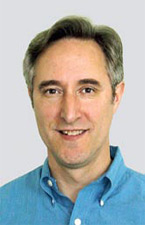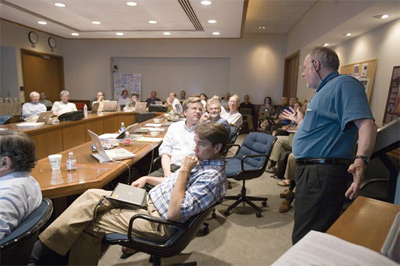Commentary: Andrew Lankford
 |
| Photo courtesy of Andrew Lankford |
Fermilab steering group
When Fermilab Director Pier Oddone asked me to join a group to consider possible intermediate-term accelerator-based physics opportunities at Fermilab in case construction of the International Linear Collider does not proceed on the proposed timeline, I was pleased to participate. I strongly believe that the ILC should be the next major project for our field, and I am eager for it to proceed as quickly as possible.
Nevertheless, building the ILC will be challenging. If it cannot go forward as rapidly as conceivablefor instance due to the time needed to forge international agreementsthere are real physics opportunities in the interim that will keep our field vital. A well-conceived project that builds on existing Fermilab facilities and at the same time fosters ILC development can create genuine opportunities for discovery.
Fermilabs primary goal beyond its current program should be to make the ILC a reality. Fermilab should also strive to host the ILC, both to help achieve the ILC and to bring to the United States a next-generation facility for exploring Terascale physics. Fermilab has aligned its priorities with these goals, and the laboratory is actively pursuing a significant and growing program of ILC research and development.
Should the timeline of the ILC unavoidably slip, the ideal project for Fermilab would have several features. First and foremost, it should provide outstanding opportunities for physics while substantially advancing the development of the ILC. The project should naturally fit within the time before the ILC begins, its costs should not slow ILC development, and it should serve a sizable number of scientific users. Synergy with other national projects and science goals, for instance the Deep Underground Science and Engineering Laboratory and searches for nucleon decay, would create added benefit.
What are the physics opportunities that an interim project could create? Among the many possibilities, the fields of neutrino physics and precision physics with charged leptons and quarks offer the most promising pathways to physics not covered by the Large Hadron Collider, the eventual ILC, or non-accelerator physics. A facility that provides unique opportunities for neutrino and precision physics will attract many users.
The promise of discovery by future neutrino experiments is well known, as is the importance of completing our understanding of neutrino masses and neutrino mixing and searching for matter-antimatter asymmetry in neutrinos. Next-generation neutrino experiments, including NOνA at Fermilab, will answer some of our questions; but discovering whether neutrinos can explain matter-antimatter asymmetry will require further experiments. As reported recently by the DOE-NSF Neutrino Scientific Assessment Group, future neutrino experiments will require higher-intensity beams and larger detectors than are currently planned, as well as greater distances between neutrino source and detector. A neutrino beam from Fermilab directed at a detector in the DUSEL underground laboratory would offer such an opportunity. A large, DUSEL-sited neutrino experiment could also perform sensitive new searches for proton decay as well as measurements of astrophysical neutrinos.
During recent painfully tight financial times, the United States has bypassed or cancelled compelling precision experiments in favor of higher-priority projects. Nevertheless, such experiments, which look for manifestations of ultrahigh-energy phenomena in their tiny effects on lower-energy processes, continue to have real discovery potential. An experimental search for the conversion of muons to electrons would probe the physics of the unification of forces and matter to very high mass scales, well beyond the reach of the LHC. Sensitive searches for rare kaon decays could also detect new physics beyond the reach of the LHC. Precision experiments such as these, which address fundamental open questions with unmatched sensitivity, have great physics merit and potential for discovery.
 |
| Photo: Reidar Hahn, Fermilab |
Since achieving the ILC remains our highest priority, an interim project should foster development of ILC technology at a pace faster than ILC R&D could achieve alone. Incorporating ILC technology into a new superconducting linear accelerator could achieve this goal. Combined with existing Fermilab accelerators, the new linac would create an interim Fermilab facility with significant discovery capabilities. By using cavities and cryomodules manufactured by US industry, such a facility would foster the industrialization of ILC components, a crucial step in ILC development. The facility could also serve as a system test for ILC technologies, providing valuable experience leading to greater robustness and reliability. Of course, the projects planners should collaborate closely with the global ILC community to develop concepts for synergy between an interim project and the ILC.
An interim facility at Fermilab, using or upgrading existing accelerator facilities where feasible and incorporating a new ILC-like linac, could provide discovery opportunities in both neutrino and precision physics. It could also offer an excellent opportunity for synergy with ILC development.
Planning for an interim project as a contingency to the ILC timeline poses definite challenges. Such planning should not convey to our government sponsors or to our US or foreign colleagues a weakening in our resolve to construct the ILC as soon as possible. Consistently communicating that the ILC is Fermilabs highest priority; that Fermilab is doing everything in its power to make the ILC a reality; and that the laboratory will pursue the interim project only if the ILC schedule slips significantly will address this problem. Fermilab must also carefully articulate the physics case and ILC synergy of an interim project. Note that Fermilabs plan directly responds to a request from Dr. Raymond L. Orbach, DOE Under Secretary for Science, to plan how to keep Fermilab vibrant in case the ILC does not happen on our desired timescale.
Another challenge is to determine the time interval for achieving an interim project without slowing ILC development. We will probably not know how far in the future the construction of the ILC lies until the lengthy process of government approvals and budgetary allocations has successfully concluded. Aligning an interim project with the ILC can mitigate this uncertainty. Design and planning should begin soon, to be ready to pursue an interim project should the need arise. Scientific goals that can be achieved relatively quickly and expanded if the timeline lengthens will also help.
If the ILC unavoidably falls behind its proposed timeline, US particle physics needs a vital accelerator-based physics program at Fermilab to maintain the momentum of our field and the vitality of the US accelerator and experimental physics community. If the United States hopes to host the ILCor, if the ILC is sited off-shore, to build a large accelerator-based facility such as a neutrino factory or muon collider further in the futurewe must maintain the vitality of accelerator physics at Fermilab, our national accelerator laboratory. If we hope to prepare future generations of US particle physicists to exploit the scientific potential of facilities such as the ILC, we must maintain compelling experimental opportunities in the United States as well as overseas.
Andrew Lankford is a professor in the department of physics and astronomy at the University of California, Irvine. He is a member of the Fermilab Steering Group charged with developing a roadmap for the future of accelerator-based particle physics at Fermilab.
Click here to download the pdf version of this article.


